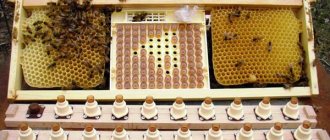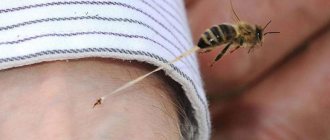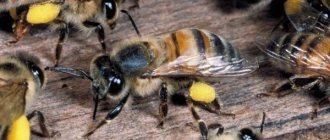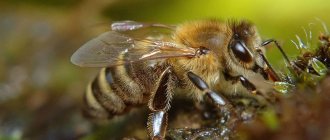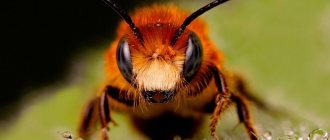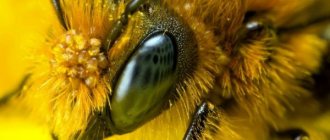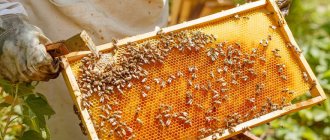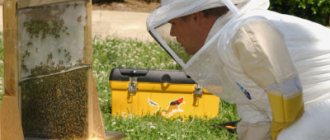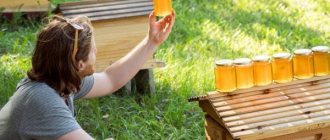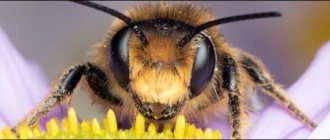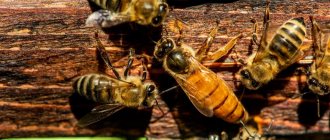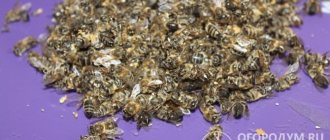A beehive is a separate, interesting world, with a special hierarchy.
Here, each bee occupies an important place and brings benefits to its family. To obtain honey in good quantities, every novice beekeeper must first of all know how bees reproduce and develop.
There are three types of bees in each hive:
- The queen of the hive is the queen bee. Its main function is the production of new individuals.
- Working insects - these individuals produce honey and care for the new brood, queen and drones.
- Drones are male individuals whose main task is to fertilize the uterus.
Development of a bee embryo in an egg
The structure of a bee
The egg laid by the queen is glued to the bottom of the cell and is initially located parallel to the walls of the cell.
The development of the embryo in the egg lasts about three days. As the embryo develops, the egg leans more and more to one side, and on the third day it lies at the bottom of the cell. Judging by the position of the egg in the cell, it is possible to determine the time of its laying by the queen (Fig. 12).
By the end of the third day, the shell of the egg bursts and a larva is born - a small milky-white worm. Shortly before the larva emerges, nurse bees place food (milk) into the cell of the honeycomb in an amount that is two to four times the weight of the larva. Until the food is placed in the cell and wets the shell of the egg, the larva will not hatch from the egg. If food is not supplied at all, the egg dries out and turns black.
Swarming
Swarming is the division of one bee colony into several parts, where the young queens, taking part of the swarm with them, fly to another place, the remaining ones are grouped near the old queen bee.
The separation itself begins a long time after this happens. In May, nectar collection begins to decrease, because... Only in June do the main honey plants begin to bloom. A large number of worker bees accumulate in a bee colony and then they can go into a state of swarming. When spring comes, the young generation, which has a lot of energy, replaces the wintering insects. They are able to feed a larger number of larvae. This is why the bee population is growing so quickly.
Sometimes bees begin to cluster abundantly near the hive. This may be in cases where weather conditions do not allow bees to work or there are very few honey plants. During this time, they do nothing and their performance decreases.
Bee larval development
The larva emerging from the egg looks like a legless worm and lies motionless at the bottom of the cell with a curl in the shape of the letter “C”. As it grows, it more and more takes the shape of a ring, and the grown larva stretches along the cell.
Development of a worker bee
Eggs: / – an egg just laid by the queen; 2 – yayio on the second day; 3 – three-day egg.
Larvae: 4 – one-day old; 5 – two-day; 6 – three days; 7 – four days; 8 – six-day (cell printing begins). Pupae: 9 – transformation of the larva into a pupa; 10 – pupa at rest.
The body of the larva is covered with a thin chitinous skin. The larva does not yet resemble a bee in any way. It lacks wings, legs and other appendages of adult bees. Its internal organs are also structured differently: there is no honey crop yet, and the midgut occupies most of the larva’s body and is a tube that does not communicate with the rectum. Therefore, the larva does not defecate, and all the feces accumulate in its midgut. Only at the end of the larval stage, just before pupation, the accumulated feces breaks through the thin partition separating the midgut from the rectum and is ejected to the bottom of the cell.
During growth, the larva molts four times, that is, it sheds its shell, which becomes tight; each time, instead of the shed one, a new, more spacious skin grows.
Bee development
What does a bee larva eat?
During the first time of its life, the larva receives very nutritious food - milk. By the end of the third day, the larvae of worker “bees” begin to receive coarser food - a gruel consisting of a mixture of honey and bee bread. The larvae are very voracious. Nurse bees continually add food to them. But they grow quickly: by the end of the sixth day, the worker bee larva already fills the entire cell, increasing in weight by more than 1300 times.
The abundance of food consumed leads to the accumulation in the larva's body of a large amount of nutrients in the form of a fat body, constituting up to 65% of the larva's weight. Its reserves of nutrients are consumed during further development - in the pupal stage, which does not receive or eat food.
When does a bee larva emerge from the cell?
When the larva grows, it stops consuming food and stretches its head towards the exit of the cell. By the end of the sixth day of the larval stage, the bees seal the cell with the larva with a porous lid consisting of wax mixed with pollen. This cap does not interfere with air exchange. The larvae before sealing are called open brood, after sealing - closed, or sealed brood, and the eggs laid by the queen until the larvae hatch from them are usually called seeding
In a sealed cell, the larva molts for the fifth time, and then spins a dense brown cocoon around itself and within 24 hours turns into a motionless pupa, basically already similar to an adult bee.
The pupa is initially white. However, soon it gradually darkens, and first of all the eyes acquire a purple tint, and then the head, chest, and abdomen darken.
Usually on the 11th or 12th day after the cell is sealed, the last (sixth) molt occurs. And by the end of the 12th day, the bee gnaws through the lid of the cell and goes outside. The shells (“shirts”) of larvae and pupae and the feces of the larvae remain in the cells, changing the color of the comb.
The entire development of a worker bee, from the egg stage to its exit from the cell, lasts 21 days.
Formation of an adult insect
The changes that began in the pre-pupal stage gradually transform the shapeless insect into an adult: the abdomen, chest and head are formed, on which antennas, mouthparts, as well as simple and compound eyes are already drawn. In the thoracic part, the formation of rudiments of legs and two pairs of wings occurs. The dorsal rings, tergites, enlarge on the abdomen. The abdominal semirings are sternites, covering the lower part of the abdomen and connected to each other and to the tergites by a thin film. The fat body decreases sharply, because with the end of nutrition it is only a source of energy for the transformation of larval organs.
The nutritional reserves accumulated in the body during the intensive period of feeding are gradually formed into future organs. Along the way, a change in body color occurs: from light yellow through purple to black or brown. The coloring process begins with the eyes and proceeds to the head, chest and abdomen.
Features of uterine development
Queens and worker bees develop from the same fertilized eggs; in this case, bees are hatched in bee cells, and queens are hatched in queen cells. However, the appearance of a queen or worker bee depends not only on the size and shape of the cells. The quality of food plays a decisive role in the formation of these two forms of females: the larvae of future queens feed only on milk all the time, and the larvae of worker bees, starting from the age of three days, receive coarser food - gruel.
Bee development table
The egg stage in queen bees, as well as in worker bees, lasts three days, but the cell with the queen larva is sealed somewhat earlier - after five days (in worker bees - by the end of the sixth day). In a sealed queen cell, the uterus develops within eight days, and the entire development of the uterus lasts 16 days.
In beekeeping practice, however, such a long period of time is not required to hatch queens. When artificially hatching queens, the starting material is not an egg, but a young larva no older than one day old. Thus, the time for the uterus to emerge is shortened to 12 days.
The purpose of worker bees in different periods of life
Throughout its life, a worker bee performs some functions in the family. They depend on the age of the individual:
- the first days of life - heating the brood;
- 3-5th day of life - cleaning flight around the hive, removing garbage, guarding the entrance (individuals);
- 4-10th day of life – production of royal jelly;
- 10-18th day - wax secretion (for this there are special glands that develop at this stage);
- from the 20th day of life - the beginning of the flight period, nectar collection.
The functions of worker bees are not clearly differentiated by time frame. The development of different individuals of the same brood may differ.
Drone development
Bee colony
The development of the drone is basically similar to the development of the worker bee. The total duration of drone development in comparison with the development of the worker bee and queen is shown in the table.
Drone printed brood is very different in appearance from bee brood. The drone is longer than the worker bee and does not fit into a cell of normal length. Therefore, bees seal the drone cells with taller, convex caps.
Sometimes drones are hatched not in drone cells, but in bee cells. Sowing drone bees into bee cells can be done by drone bees, unfertilized queens, old queens, and also tinder bees. The large drone larva does not fit into the cramped bee cell at all and bulges outward.
When sealing a bee cell with a drone larva, the bees make even more convex lids, as if placing a thimble on the cell. Such brood sealed in bee cells is called humpbacked brood.
Depending on environmental conditions - the temperature in the nest, the state of food, the strength of the family, the quality of food, etc. - the development time of each individual may deviate in one direction or the other by one or two days.
Role in the family and difference from relatives
The main indicator of the quality of a queen is the number of eggs she lays. From here, the strength of the bee colony and the volume of collected honey during the summer period are directly related. The queens of a hive are considered good if they have laid at least two thousand bee eggs during the season. In this case, the eggs may or may not be fertilized. The first to emerge are the worker bees and queens, and the unfertilized ones are the drones.
The appearance of the queen bee is significantly different from her relatives. It is approximately twice the size of the rest of the family and has an abdomen that protrudes strongly beyond the wings. Her eyes, despite their size, are somewhat smaller than those of her “subjects”.
In the case when the hive works harmoniously, there is only one queen in it. She lives for approximately 5 years, but due to decreased productivity, as a rule, beekeepers change queens every 2 years.
The main bee lives only in the hive itself, rarely leaving it during mating or swarming
The queen is constantly guarded by several worker bees, and due to this important role, they are exempt from nectar collection. Feeding and protecting the queen bee is their job.
To eat, the head of the family takes short breaks during the process of laying eggs.
Peculiarities of bees wintering outside in different regions
The importance of environmental conditions
According to Michurin biology, with the same heredity, under different developmental conditions, organisms of different qualities are obtained. Therefore, the quality of individual bees and the colony as a whole depends not only on the quality of the eggs laid by the queen, but also on the growing and feeding conditions of the larvae developing from these eggs.
The influence of the external environment on the development of bees
During the period of growth and development, the bee colony responds very sensitively to the slightest changes in environmental conditions (temperature, air humidity, quantity and quality of food, etc.).
If the larvae are raised in a weak family with a lack of food, at a low temperature in the nest and other unfavorable conditions, then no matter how good the parents (queens and drones) have, the bees that develop from such larvae always turn out to have short life spans. They will be underdeveloped, smaller in size and weight, with weak muscles. Such bees bring reduced drops of nectar to the hive, inferior pollen, wear out faster and die sooner.
When the temperature drops and there is a lack of food, the normal development time of queens, drones and worker bees is extended; on the contrary, when the temperature rises above normal, their development time is shortened. However, raising the temperature to 37°, although it shortens the development time of bees by three days, entails undesirable consequences: greater death of pupae and adult bees, as well as the emergence of underdeveloped bees with various deformities.
In particularly unfavorable conditions, when, for example, the family does not have enough protein food (breadbread), the larvae not only do not develop into adult bees, but die without yet pupating.
All this shows how important it is to create the most favorable conditions for families during the period of raising brood, “families raising brood must be strong, the best temperature and air conditions must be maintained in the hives, there must be an abundance of food in the nests - honey and beebread. We must also not forget about supplying bees with water, especially in early spring, when they are often unable to fly out of the hive.
Feeding conditions for domestic bees
Feeding conditions play an extremely large role in the formation of valuable economically useful traits in domestic animals. This important proposition of Michurin biology is entirely applicable to bees; it should also be taken into account when breeding queens.
The nurturing family, i.e., the family that feeds queens from larvae, must not only be provided with food and have a sufficient number of worker bees, but even bees for its formation must be taken from families that have shown the best honey and wax productivity, as well as resistance against disease. Larvae for brood rearing should also be taken from families that are outstanding in terms of productivity.
Maintain humidity and optimal temperature
As early as February, the queen may begin laying eggs in the honeycomb. It is after this that all the bees in the family begin to regularly maintain the temperature in the hive, and also monitor the humidity in the place where the cells with the baby are located.
The optimal temperature for the development of laid eggs should be between 33-35 degrees. It is important to note that it mainly depends on the outside temperature. A sharp decrease, for example, to 31-32 degrees, leads to a deterioration in the development of future bees, as well as some deficiencies in the quality of the pupae - for example, poorly developed wings. Obviously, such an individual will die very quickly. If there is a sharp increase in temperature, at least to 36 degrees, then all the pupae will die.
Use of brood
The brood is very rich in biologically active compounds, as it has an insatiable appetite and actively consumes all the available nutritional resources of the swarm. It has long been proven that brood can effectively cure many diseases, the main thing is that only those larvae that are no older than three days should be used for treatment!
Beneficial properties of open brood:
- Treatment of dystrophy in children
- Prevention and treatment of rickets
- General strengthening effect on the human body
- Normalization of blood pressure
- Strengthening the immune system
- Brood is effective in the treatment of diseases of the cardiovascular system.
- Relieves symptoms of vegetative-vascular dystonia;
- It has an antitumor effect and is used as cancer prevention.
